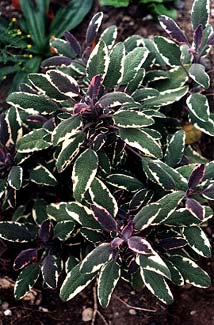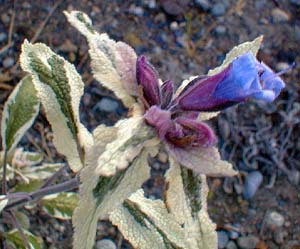
Tricolored Salvia
a Decorative, Medicinal, & Culinary Sage
"At morn or eve, in your retired domain,
Perchance you not unfrequently have marked
A Visitor -- in quest of herbs & flowers;
Too delicate employ, as would appear,
For one, who, though of drooping mien, had yet
From nature's kindliness received a frame
Robust as ever rural labour bred."
-William Wordsworth
(1770-1850)
(1770-1850)
Salvia officinalis is the basic Eurasian sage long famed for culinary & medicinal value, but it is also highly decorative in the garden, & has several beautiful & sweetly aromatic cultivars. The cultivar shown here is 'Tricolor' photographed in August. It one-ups the usual 'Purpurea' (Purple Sage) by mixing green, white, & purple foliage on a single pubescent-leafed plant.
This colorful strain is particularly hardy & grows rapidly. It grows at a vastly faster rate than a another S. officinalis cultivar planted nearby, 'Icterina' or Golden Variegated Sage. 'Tricolor' & 'Icterina' are cold-hardy down to the minus ten to zero degree range.
As an extremely drought-hardy evergreen groundcover, Tricolored Sage is a perfect plant for a low-maintenance sun-garden, though too extended a waterless period will harm it, as will poor drainage especially in a wet winter. Though it makes it through our mild winters not too badly damaged, by winter's end it can look a bit tawdry & demand a good trimming to make room for new leafage. A winter's end trimming of any worn-out leaves is sufficient; thinning later in the year is usually not necessary, but can be done even so, in order to obtain the leaves for use in the kitchen.
 It will not be worse for wear if it experiences continuous light harvesting spring through autumn, & will even benefit by having bits harvested as this will help keep good air-circulation through the remaining leaves, so there won't be any opportunity for mildew or heat exhaustion.
It will not be worse for wear if it experiences continuous light harvesting spring through autumn, & will even benefit by having bits harvested as this will help keep good air-circulation through the remaining leaves, so there won't be any opportunity for mildew or heat exhaustion.It fluffs up to about 16 inches of height, with considerable potential for spread. Though valued for foliage more than flowers it in fact it has lovely racemes of violet-blue flowers in June. The second photo shows the June flowers. Approximately every third year it should be dug up & divided to rejuvenate the plant. If it is never divided, then in five or six years it will decline & cease to be compact & pleasantly leafed, & by then could well need replacing entirely.
The species name officianalis is attached to other herbs as well, & indicates plants with traditional medicinal uses. The medicinal qualities of many herbs gets greatly exaggerated by the misnomered "health food" industry which, when cornered, admit they're only selling food supplements, not medicines, all the while counting on the public to deceive themselves, assisted by deceptive literature continously promulgating hokum in alternative-health or vegetarian books, magazines, & pamphlets. Happily enough, however, sage has a greater credibility than most of the dried out bits of garden rubble sold as "food supplements" & for which medicinal claims are largely or wholy founded on superstition.
Sage has traditionally been regarded as useful to stop spasms, as an astringent & antiseptic, as a nerve tonic, & for colds, soar throats, toothaches, as an antibacterial mouthwash, & to treat inflammation, wounds or cancers. It has been used for millenia for its healing properties & very name "Salvia" is derived the Latin word for "to heal" or "preserve in safety." When subjected to rigorous scientific testing, not all the alleged healing values turn out to be valid, but many of the traditional claims are substantially correct.